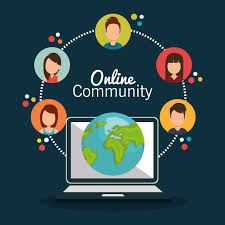
Social Networks: Definition, Evolution, and Modern Relevance
In today’s digital-first world, the phrase “online social network” is one of the most frequently used terms across media, education, and everyday conversations. Whether you’re scrolling through Instagram, debating on Reddit, or maintaining professional contacts on LinkedIn, you’re engaging with an online social network.
But what exactly does the term mean? Is it just a digital tool for communication, or is it something more profound—a new form of human interaction shaped by technology?
This article offers a comprehensive, human-centered exploration of online social networks, starting from their definition and stretching through their evolution, types, characteristics, uses, and impacts on modern life.
Defining Online Social Networks
At its core, an online social network (OSN) is a digital platform that facilitates social interaction and connection between individuals or groups over the internet. These networks allow users to create personal profiles, connect with others, share content, and engage in conversations, often asynchronously.
In simpler terms, online social networks are websites or applications that help people build relationships, exchange information, and participate in digital communities.
The Technical Foundation of Online Social Networks
From a technical perspective, an OSN consists of three main components:
- Nodes – The individual users or entities (e.g., businesses, organizations).
- Edges or links – The relationships between the users (e.g., friendships, follows, likes, comments).
- Content – The actual data shared, such as text, photos, videos, or links.
In this structure, the entire system resembles a web or “network” of interconnected individuals, not unlike the real-world social circles people navigate daily.
Brief History: The Evolution of Online Social Networks
To understand the current landscape, it’s helpful to look back at how online social networks began and evolved.
The Early Days (1970s–1990s)
- Bulletin Board Systems (BBS): Before the internet became widely available, users would dial into local computer servers to exchange messages.
- Usenet and IRC: These were among the first real-time communication platforms where people could join thematic discussion groups.
The Rise of Web-Based Platforms (1997–2005)
- Six Degrees (1997): Often considered the first true online social network, it allowed users to create profiles and connect with friends.
- Friendster, MySpace, and Orkut (early 2000s): These platforms added customizable profiles, friend lists, and multimedia sharing, sparking mass adoption.
The Social Media Explosion (2006–2015)
- Facebook (2004): Originally for college students, Facebook redefined the social media space with its real-name policy and news feed algorithm.
- Twitter (2006), LinkedIn, Instagram (2010): These sites catered to different niches—microblogging, professional networking, and visual sharing, respectively.
The Era of Mobile and Video (2015–present)
- Snapchat, TikTok, and Clubhouse: Newer platforms have focused on ephemeral content, short-form video, and real-time audio interaction.
- Integration with AI and VR: Social platforms now use artificial intelligence to personalize content and are experimenting with virtual spaces (like the metaverse).
Key Characteristics of Online Social Networks
Despite their diversity, most OSNs share several defining features:
1. User-Generated Content
Users, not administrators or media companies, create and publish most of the content. This democratizes information sharing but also creates challenges around misinformation and moderation.
2. Two-Way Communication
Unlike traditional media, which is largely one-way, online social networks encourage interaction. You can comment, reply, like, or share content, fostering real-time dialogue.
3. Profile-Based Identity
Most platforms require users to create profiles. These profiles may be real, anonymous, or pseudonymous and often include photos, bios, and activity logs.
4. Community Building
OSNs enable users to join groups, follow hashtags, or subscribe to channels, helping like-minded people connect over shared interests.
5. Algorithmic Feeds
Content visibility is largely determined by algorithms. These mathematical formulas analyze user behavior to recommend posts, people, and ads.
Types of Online Social Networks
Online social networks can be categorized based on purpose, functionality, and audience.
1. General-Purpose Networks
- Examples: Facebook, Twitter (X), Google+
- Purpose: Allow users to connect with friends, family, and the public. Supports diverse media types and engagement styles.
2. Professional Networks
- Examples: LinkedIn, AngelList
- Purpose: Designed for career development, recruitment, networking, and professional branding.
3. Interest-Based Networks
- Examples: Reddit, Pinterest, Goodreads
- Purpose: Cater to specific hobbies, interests, or communities, often through forums or thematic boards.
4. Media Sharing Networks
- Examples: YouTube, TikTok, Instagram, Snapchat
- Purpose: Focus on sharing visual content such as videos, photos, and live streams.
5. Anonymous or Pseudonymous Networks
- Examples: 4chan, Whisper, Yik Yak
- Purpose: Allow anonymous posting, often appealing to users who seek free expression without identification.
6. Enterprise or Private Networks
- Examples: Slack, Yammer, Microsoft Teams
- Purpose: Used within companies or organizations to streamline communication and collaboration.
The Role of Online Social Networks in Modern Life
Online social networks have penetrated nearly every aspect of contemporary life. Here’s how:
1. Personal Relationships
From reconnecting with old friends to finding romantic partners, OSNs have transformed how people initiate and maintain relationships. Video calls, emojis, and story-sharing make long-distance relationships more bearable.
2. Education and Learning
Educators and students use platforms like Facebook Groups, LinkedIn Learning, and even TikTok for sharing educational content. Social networks also enable peer-to-peer learning.
3. Marketing and Business
Businesses use OSNs for brand promotion, customer engagement, influencer marketing, and product launches. Instagram and TikTok, in particular, have become essential for e-commerce.
4. Social Movements and Activism
Hashtags like #MeToo, #BLM, and #ClimateAction have demonstrated the power of OSNs in organizing global movements. They provide a voice to the voiceless and amplify grassroots efforts.
5. Mental Health and Peer Support
Social networks offer platforms for mental health advocacy and support communities. People dealing with anxiety, depression, or addiction often find solace in online groups.
Risks and Challenges of Online Social Networks
Despite their benefits, OSNs come with significant drawbacks that affect users and society.
1. Privacy Concerns
Users often share personal information without realizing how it’s being used or stored. Data breaches, unauthorized surveillance, and tracking are growing concerns.
2. Misinformation and Echo Chambers
Algorithms can trap users in information bubbles, reinforcing their beliefs and limiting exposure to diverse viewpoints. Fake news and conspiracy theories thrive in such environments.
3. Addiction and Mental Health Issues
The dopamine-driven design of OSNs leads to compulsive behavior. Constant notifications and the pressure to present a perfect life can contribute to anxiety, depression, and low self-esteem.
4. Cyberbullying and Online Harassment
Anonymity and distance reduce social accountability, increasing the prevalence of harassment, especially among teens and marginalized groups.
Future of Online Social Networks
As technology evolves, so will online social networks. Several trends are shaping their future:
1. Decentralized Social Networks
Platforms like Mastodon and Bluesky are exploring non-centralized models where users control their data and content moderation is community-driven.
2. AI Integration
From content recommendations to language translation and even chatbot companions, AI is becoming deeply embedded in OSNs.
3. Virtual and Augmented Reality
With the growth of the metaverse, virtual social networks may allow users to “meet” in 3D environments using avatars, creating more immersive social experiences.
4. Stronger Regulation and Ethics
Governments and watchdogs are pressuring platforms to adopt ethical practices, ensure user data protection, and control the spread of harmful content.
Conclusion
Online social networks have redefined the way humans interact in the digital age. They’re not just tools for sharing selfies or keeping in touch—they’re platforms where identities are formed, opinions are shaped, businesses grow, and communities thrive.
Understanding the definition of online social networks requires more than knowing how they function. It demands insight into how they influence our behavior, relationships, and societal norms. As we continue to integrate them into our lives, the responsibility lies with users, developers, educators, and governments to shape these networks in ways that promote connectivity, authenticity, and well-being.
The challenge is not to reject online social networks, but to humanize and harness them—ensuring that in our pursuit of digital connection, we don’t lose the essence of what it means to be social.



